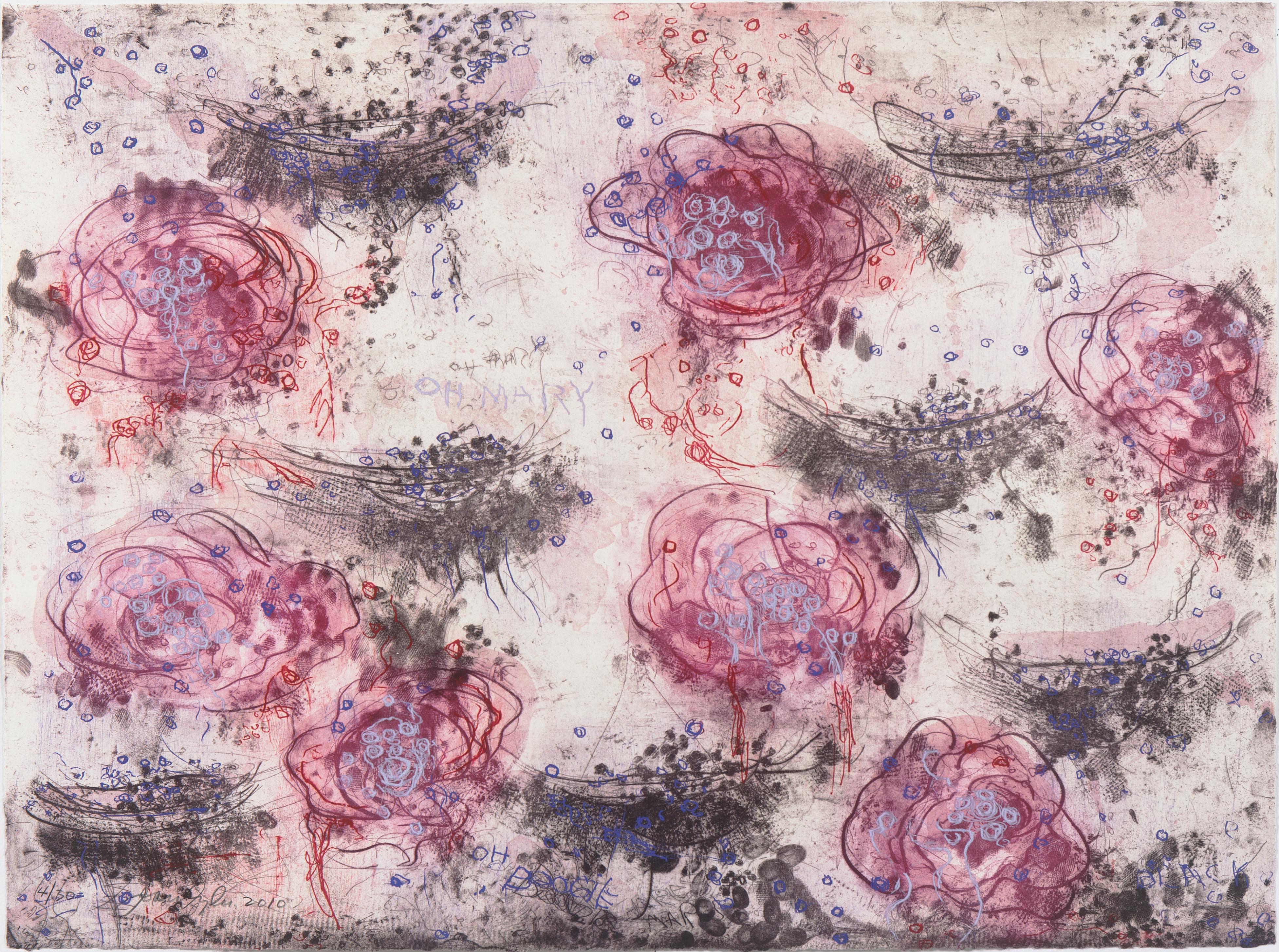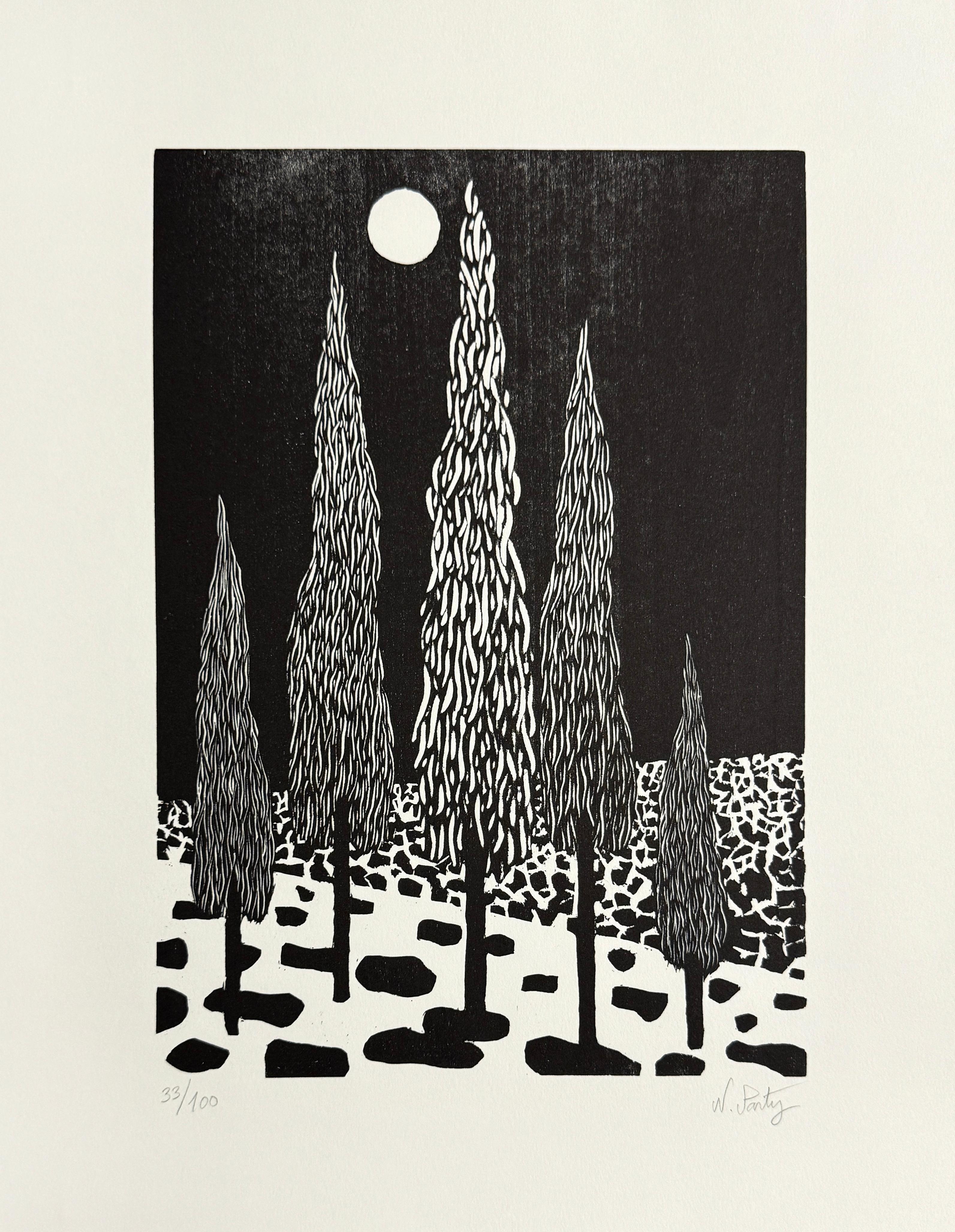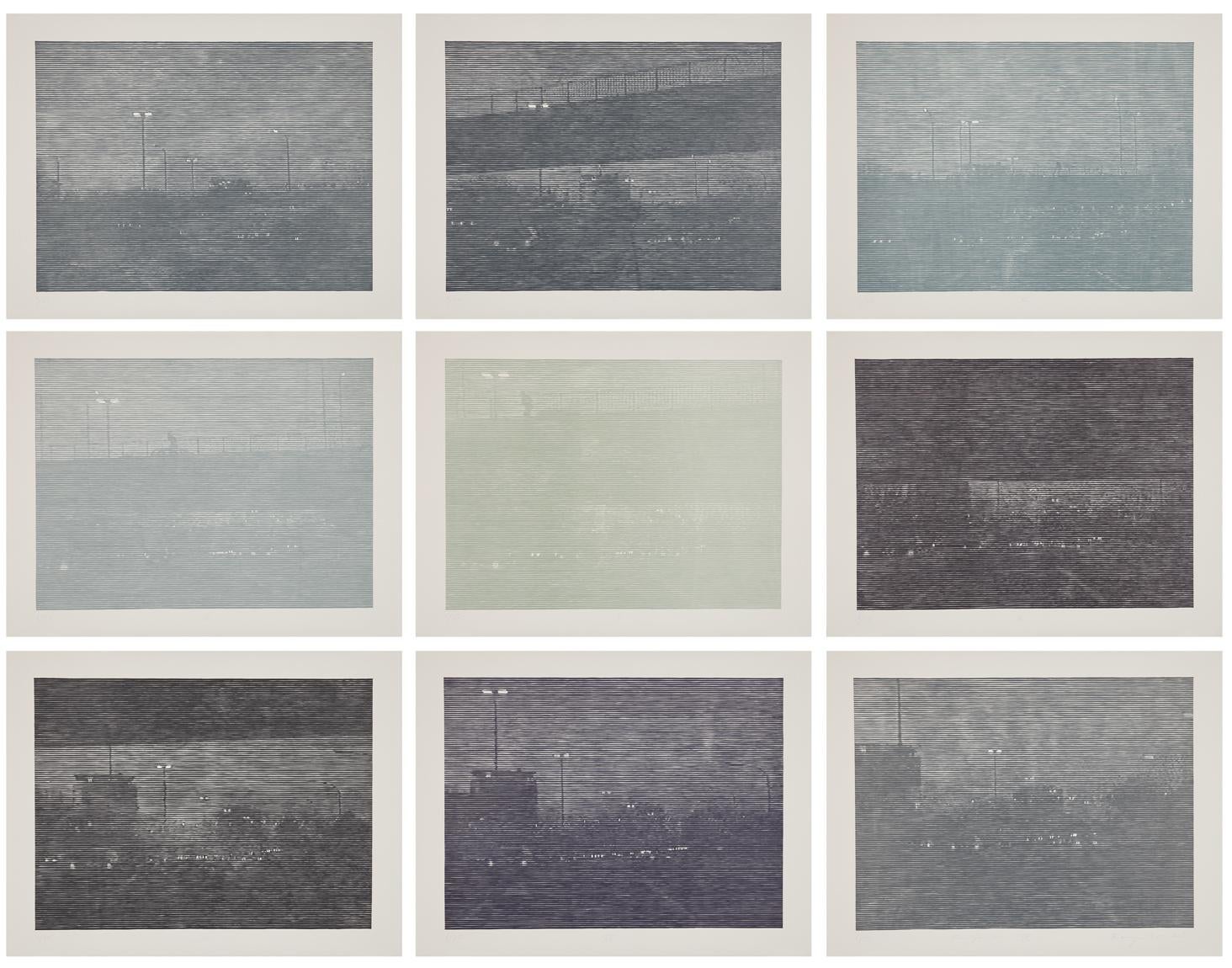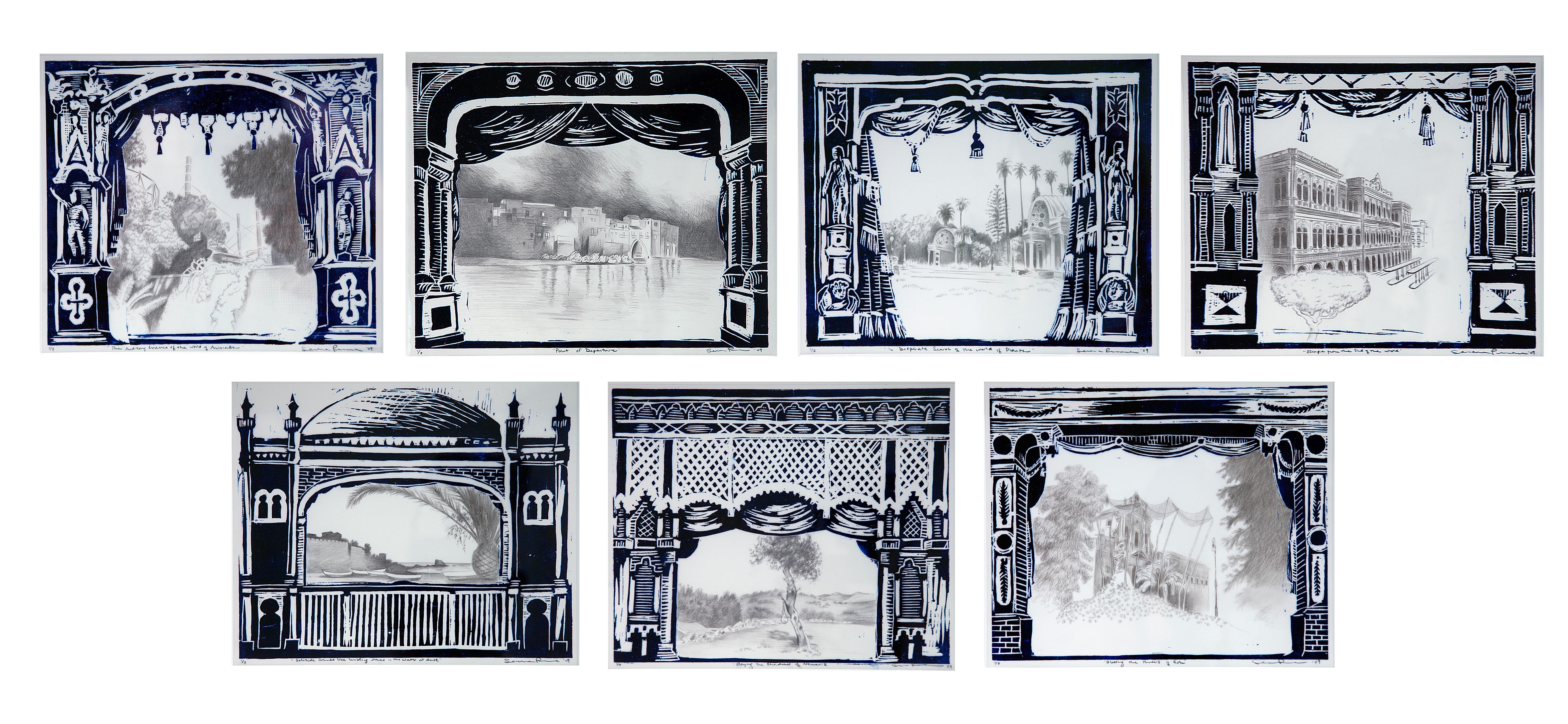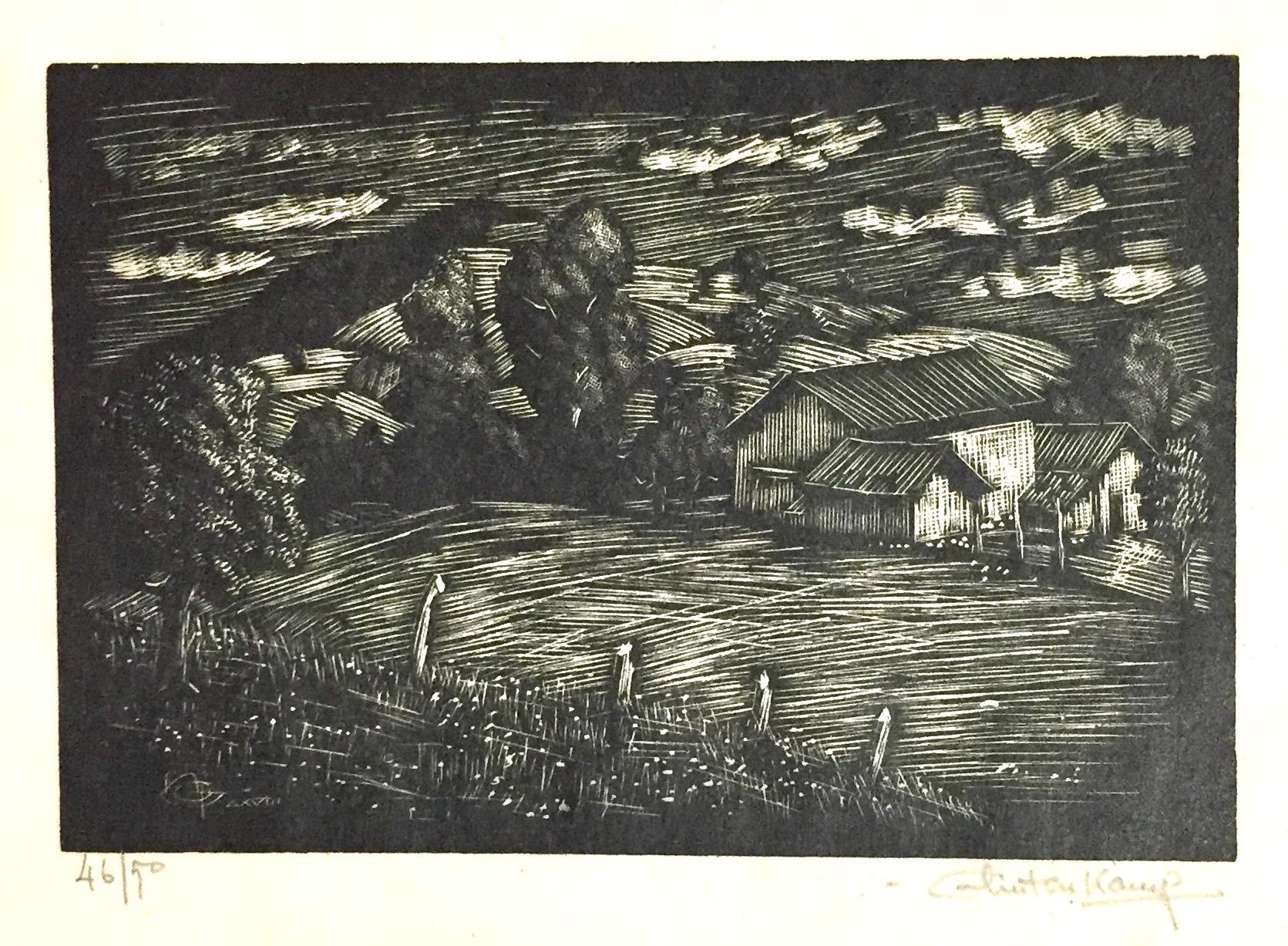Items Similar to Daybreak over Lake Yamanaka
Want more images or videos?
Request additional images or videos from the seller
1 of 8
Kawase HasuiDaybreak over Lake Yamanaka1931
1931
About the Item
Daybreak over Lake Yamanaka
Color woodcut, 1931
Published by the Watanabe Color Print Co.
Watanabe seal "D" (1931-1941) See photo
Pre-war design and pre-war printing
Lake Yamanaka is the largest of the Fuji Five Lakes
Condition: Excellent
Image size: 14 3/8 x 9 3/8 inches
Sheet size: 15 3/8 x 10 inches
Reference: Brown 252, illustrated
Kawase Hasui 1883-1957
Hasui was born with the given name Bunjiro in Tokyo, the son of a merchant family. As a child Hasui learned to paint in Western style. His first teacher was Saburosuke Okada (1869-1939) who taught him watercolor and oil painting.
His family wanted Hasui to work in the family business, and was not very happy about his artistic. The conflict was solved when the family business went into bankruptcy.
At the age of 26 Kawase applied to be a student by Kiyokata Kaburagi (1878-1972), a painter in traditional Japanese style. But Kaburagi considered him to be too old and rejected him. Kawase tried it again two years later and was finally accepted. Kiyokata soon recognized the talents of his student and introduced him to Watanabe Shozaburo.
Kawase had a tight and lifelong cooperation with the publisher Watanabe Shozaburo (1885-1962). Watanabe was the initiator and driving commercial force of the shin hanga movement. When traditional ukiyo-e printmaking was close to extinction, he gathered a handful of starving artists around him and gave them commissions for prints. Watanabe's business idea was to target these prints at art lovers. Before, ukiyo-e was a kind of mass consumer product. In this function it had no chance against photography and by the turn of the nineteenth to the twentieth century it seemed to be doomed to disappear.
Hasui Kawase created more than a hundred woodblock prints between 1918 and 1923 - all published by Watanabe Shozaburo. Most of these "new style" prints were exported - mainly to the United States. Then, on September 1, 1923, Japan was hit by one of the worst earthquakes in history. About 140,000 people died in the Kanto earthquake and the fires that raged for days. The center of the earthquake was in the Tokyo and Yokohama area.
Watanabe's print shop was destroyed by the fire and with it all of Kawase's print blocks. The artist’s home with with all of his sketchbooks was also destroyed. Kawase and Watanabe had to start again from scratch. The artist produced more than 400 woodblock designs for Watanabe until his death in 1957.
In 1956 Kawase was named a Living National Treasure by the Japanese government. It is the greatest honor an artist can experience in post-war Japan and he was the first to receive this outstanding title. He died only one year after this great honor at the age of 74.
Courtesy: Artelino
- Creator:Kawase Hasui (1883-1957, Japanese)
- Creation Year:1931
- Dimensions:Height: 14.38 in (36.53 cm)Width: 8.38 in (21.29 cm)
- Medium:
- Period:
- Condition:
- Gallery Location:Fairlawn, OH
- Reference Number:
About the Seller
5.0
Recognized Seller
These prestigious sellers are industry leaders and represent the highest echelon for item quality and design.
Platinum Seller
These expertly vetted sellers are 1stDibs' most experienced sellers and are rated highest by our customers.
Established in 1978
1stDibs seller since 2013
711 sales on 1stDibs
Typical response time: 1 hour
Associations
International Fine Print Dealers Association
- ShippingRetrieving quote...Ships From: Fairlawn, OH
- Return PolicyA return for this item may be initiated within 10 days of delivery.
More From This SellerView All
- The Infant Christ and St. John Playing with the Lamb, after Peter Paul RubensBy Christoffel JegherLocated in Fairlawn, OHThe Infant Christ and St. John Playing with the Lamb, after Peter Paul Rubens (1577-1640) Woodcut, trimmed and tipped to support Initialed in the block bottom ...Category
1630s Old Masters Prints and Multiples
MaterialsWoodcut
- River ReflectionsBy Arthur Wesley DowLocated in Fairlawn, OHRiver Reflections Color woodcut, c. 1910 Unsigned Provenance: Dow Family Album, Cincinnati Condition: Excellent Image size: 2 1/2 x 4 inches Sheet size: 3 1/8 x 4 7/8” A color varian...Category
1910s American Modern Landscape Prints
MaterialsWoodcut
- Lingering Snow Mount YoshinoBy Utagawa KuniyoshiLocated in Fairlawn, OHLingering Snow Mount Yoshino (Shidzuka-gozen toiling through snow after her last farewell to Yoshitsune) Signed: Ichiyusai Kuniyoshi ga Censor seal: Tanaka Series: Kenjo hakkei ...Category
1840s Figurative Prints
MaterialsWoodcut
- BougivalBy Maurice de VlaminckLocated in Fairlawn, OHBougival Woodcut, 1914 Signed and numbered in pencil Edition 30, this numberd 22 Printed on laid Van Gelder Zonen paper Published by Henri Kanweiler, Paris Printed by Paul Birault, Paris Bougival is located west of Paris, on the left bank of the River Seine. This woodcut was inspired by Vlaminck's 1905 Fauvist masterpiece of the same title in the collection of the Detroit Institute of Art. An impression of this image is in the Yale Univeristy Art Gallery, Condition: Very slight sun staining, otherrwise very good Image/block size: 13 1/4 x 16 1/4 inches Sheet size: 19 1/8 x 22 1/8 inches Reference: Walterskirchen 11b Maurice de Vlaminck (4 April 1876 – 11 October 1958) was a French painter. Along with André Derain and Henri Matisse, he is considered one of the principal figures in the Fauve movement, a group of modern artists who from 1904 to 1908 were united in their use of intense colour.] Vlaminck was one of the Fauves at the controversial Salon d'Automne exhibition of 1905. Life Maurice de Vlaminck was born on Rue Pierre Lescot in Paris. His father Edmond Julien was Flemish and taught violin and his mother Joséphine Caroline Grillet came from Lorraine and taught piano His father taught him to play the violin.[3] He began painting in his late teens. In 1893, he studied with a painter named Henri Rigalon on the Île de Chatou In 1894 he married Suzanne Berly. The turning point in his life was a chance meeting on the train to Paris towards the end of his stint in the army. Vlaminck, then 23 and already active in anarchist circles in Paris, met an aspiring artist, André Derain, with whom he struck up a lifelong friendship.] When Vlaminck completed his army service in 1900, the two rented a studio together, the Maison Levanneur, which now houses the Cneai,[6] for a year before Derain left to do his own military service. In 1902 and 1903 he wrote several mildly pornographic novels illustrated by Derain. He painted during the day and earned his livelihood by giving violin lessons and performing with musical bands at night. Vlaminck participated in the controversial 1905 Salon d'Automne exhibition. After viewing the boldly colored canvases of Vlaminck, Henri Matisse, André Derain, Albert Marquet, Kees van Dongen, Charles Camoin, and Jean Puy, the art critic Louis Vauxcelles disparaged the painters as "fauves" (wild beasts), thus giving their movement the name by which it became known, Fauvism. In 1911, Vlaminck traveled to London and painted by the Thames. In 1913, he painted again with Derain in Marseille and Martigues. In World War I he was stationed in Paris, and began writing poetry. Eventually he settled in Rueil-la-Gadelière, a small village south-west of Paris. He married his second wife, Berthe Combes, with whom he had two daughters. From 1925 he traveled throughout France, but continued to paint primarily along the Seine, near Paris. Resentful that Fauvism had been overtaken by Cubism as an art movement Vlaminck blamed Picasso "for dragging French painting into a wretched dead end and state of confusion". During the Second World War, Vlaminck visited Germany and on his return published a tirade against Picasso and Cubism in the periodical Comoedia in June 1942. Vlaminck wrote many autobiographies. Vlaminck died in Rueil-la-Gadelière on 11 October 1958. Artistic career Two of Vlaminck's groundbreaking paintings, Sur le zinc (At the Bar) and L'homme a la pipe (Man Smoking a Pipe) were painted in 1900. For the next few years Vlaminck lived in or near Chatou (the inspiration for his painting houses at Chatou), painting and exhibiting alongside Derain, Matisse, and other Fauvist painters. At this time his exuberant paint application and vibrant use of colour displayed the influence of Vincent van Gogh. Sur le zinc called to mind the work of Toulouse-Lautrec and his portrayals of prostitutes and solitary drinkers, but does not attempt to probe the sitter's psychology—a break with the century-old European tradition of individualized portraiture. According to art critic Souren Melikian, it is "the impersonal cartoon of a type. In his landscape paintings, his approach was similar. He ignored the details, with the landscape becoming a vehicle through which he could express mood through violent colour and brushwork. An example is Sous bois, painted in 1904. The following year, he began to experiment with "deconstruction," turning the physical world into dabs and streaks of colour that convey a sense of motion. His paintings Le Pont de Chatou (The Chatou Bridge), Les Ramasseurs de pommes de terre (The Potato Pickers...Category
1910s Fauvist Landscape Prints
MaterialsWoodcut
- A l'Exposition Universelle: La Tour EiffelBy Auguste Louis LepèreLocated in Fairlawn, OHA l'Exposition Universelle: La Tour Eiffel Woodengraving, 1889 Signed and numbered in ink by the artist (see photo) Edition: Deluxe ...Category
1880s Impressionist Landscape Prints
MaterialsWoodcut
- Blossom Time in TokyoBy Helen HydeLocated in Fairlawn, OHSigned by the artist in pencil on the image Reference: Tim Mason and Lynn Mason, Helen Hyde (Washington, D.C.: Smithsonian Institution Press, 1991), 115, reproduced in color p. 68.Category
1910s Figurative Prints
MaterialsWoodcut
You May Also Like
- Wild RosesBy Joan SnyderLocated in Brooklyn, NYWild Roses, 2010 Lithograph/etching/woodcut 28 3/8 × 38 3/8 in 72.1 × 97.5 cm This print combines etching, lithography, and woodcut to create a great variet...Category
2010s Contemporary Landscape Prints
MaterialsEtching, Lithograph, Woodcut
- TreesBy Nicolas PartyLocated in London, GBWoodcut on BFK Rives paper, produced in 2020. Edition of 100. Mint condition, unframed. Signed and numbered in pencil by Nicolas Party.Category
2010s Contemporary Landscape Prints
MaterialsWoodcut
- "Nachtfahrt"By Christiane BaumgartnerLocated in Köln, DEA wonderful and delicate portfolio by Christiane Baumgartner, artist from Leipzig/Germany. "Nachtfahrt" (night tour) consists of 9 woodcut prints on Zerkall laid paper. Each work has...Category
Early 2000s Contemporary Landscape Prints
MaterialsWoodcut
- Fictive HomelandsLocated in Providence, RIFictive Homelands is a suite of 7 woodcut prints with silverpoint drawing on mylar by artist Serena Perrone. Fictive Homelands is a series of works that use the theater proscenium ...Category
Early 2000s Contemporary Landscape Prints
MaterialsSilver
- The Colors of a Cholla Cactus After Rain in the Late Summer or Early Fall (LEFT)Located in Santa Fe, NMLayering fabrics, dyes, pigments, crystals, and various other natural materials, Martha Tuttle is a master of juxtaposing textures to explore the relationship between humans and the physical world. Her unique artworks draw upon a variety of mediums to create harmonious compositions vibrating with her artistic energy. Tuttle’s new triptych of prints — "The Colors of a Cholla Cactus...Category
2010s Abstract Abstract Prints
MaterialsIntaglio, Woodcut
- Kevin B. O'Callahan, PoplarsBy Kevin B. O'CallahanLocated in New York, NYA Rochester, New York native, Kevin O'Callahan studied at the Carnegie Institute and worked on the WPA. He is known for his Arts and Crafts period woodcuts and his later industrial s...Category
1920s Aesthetic Movement Landscape Prints
MaterialsWoodcut
